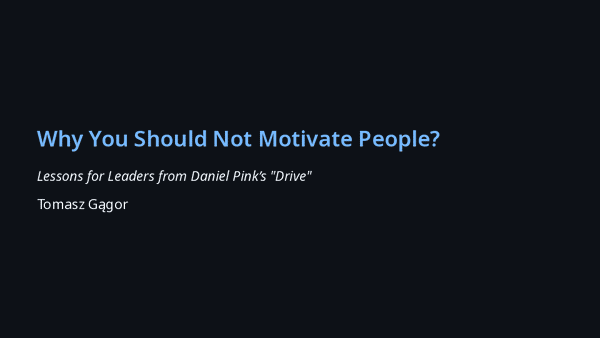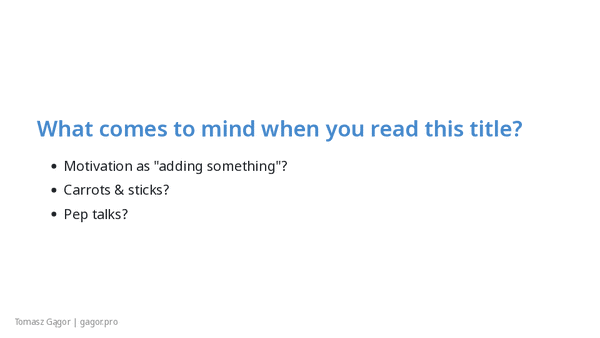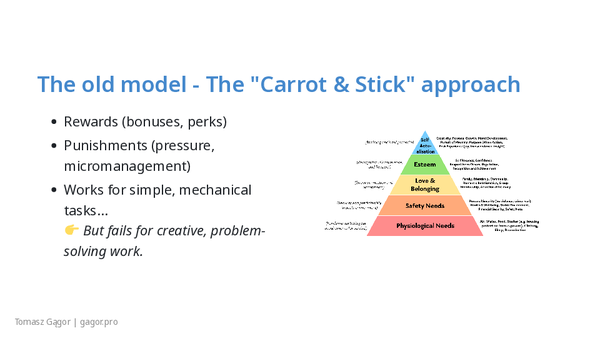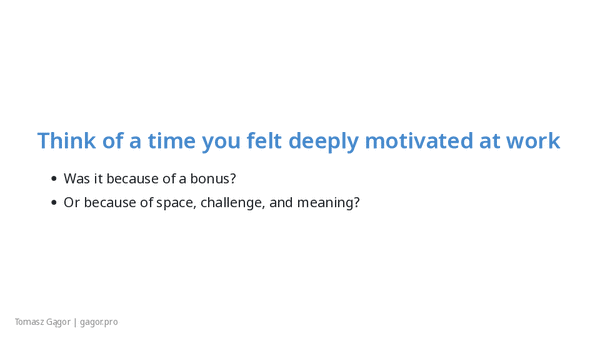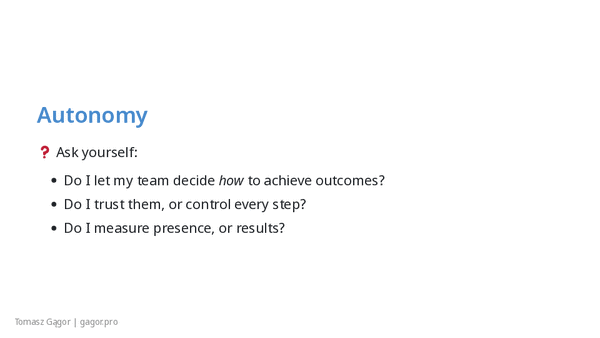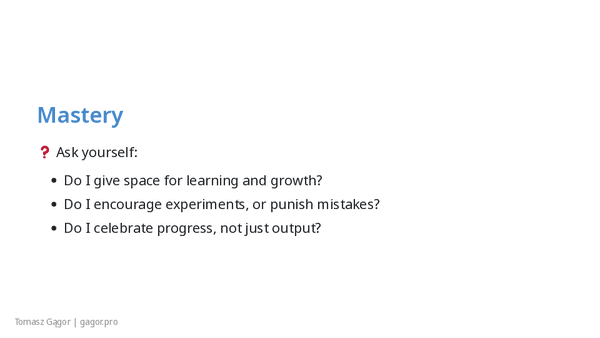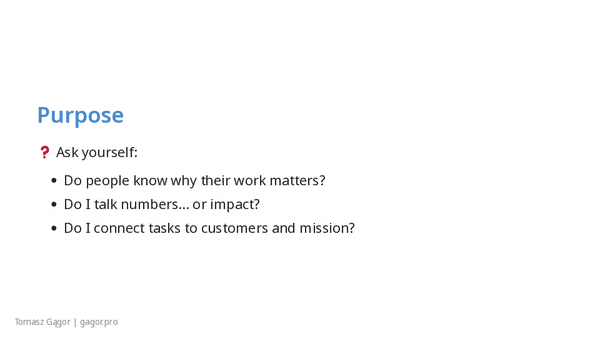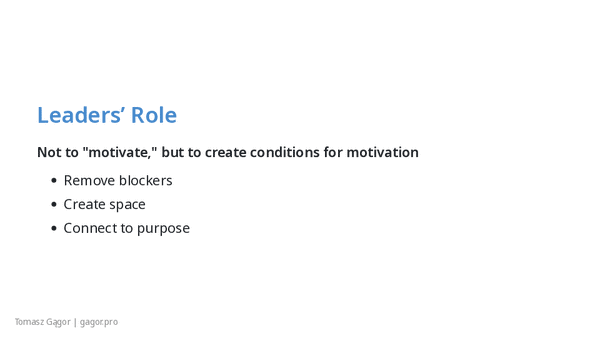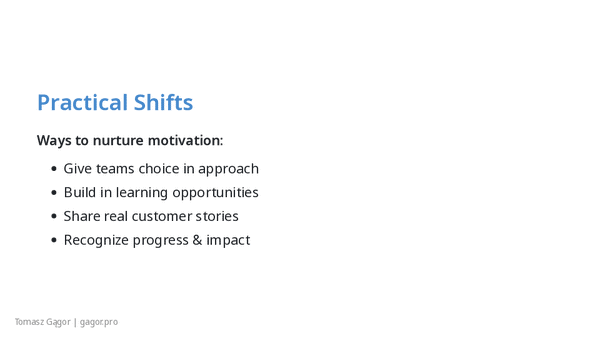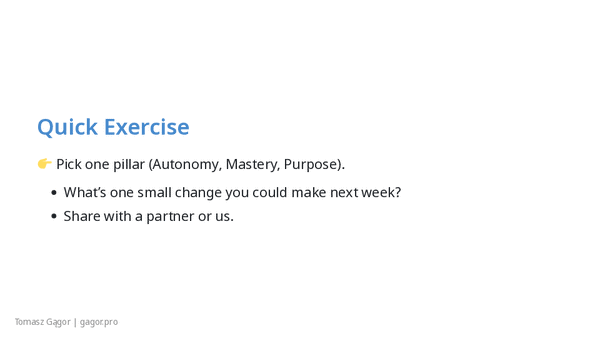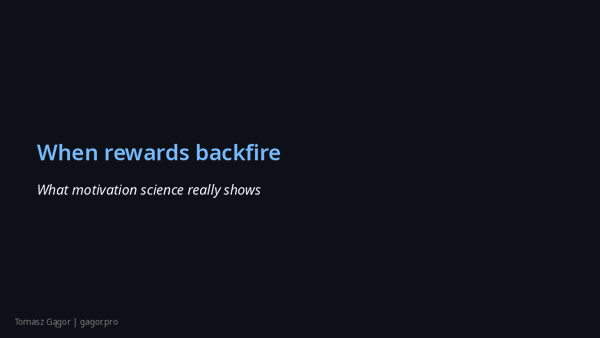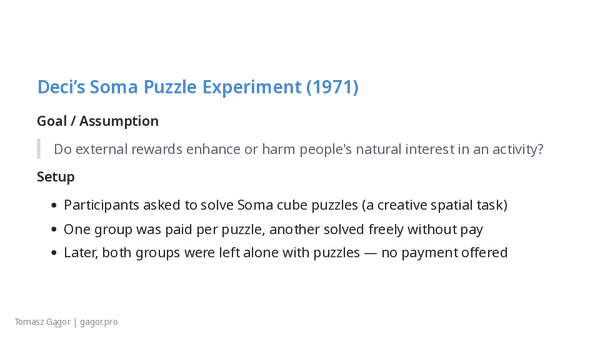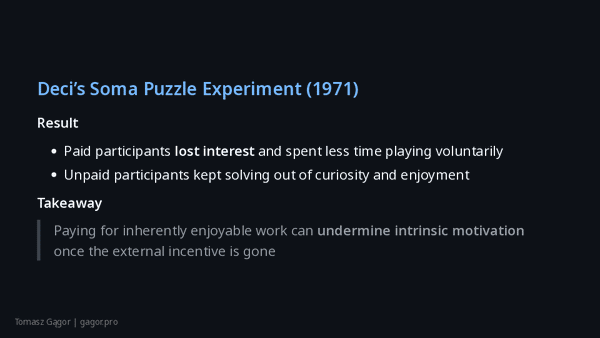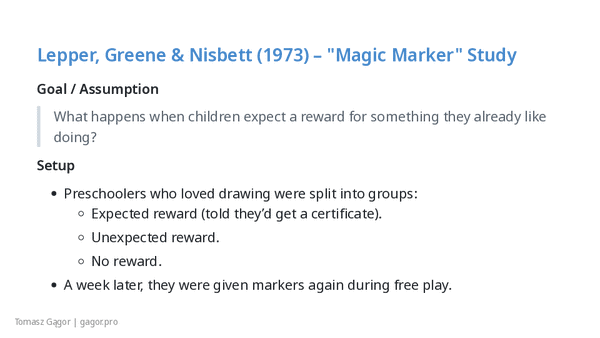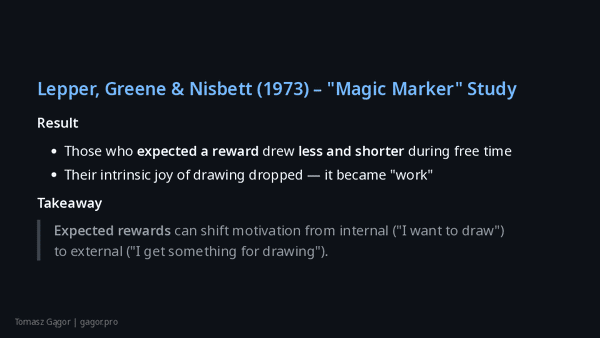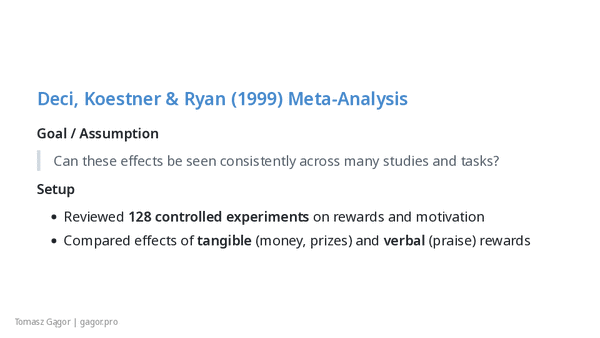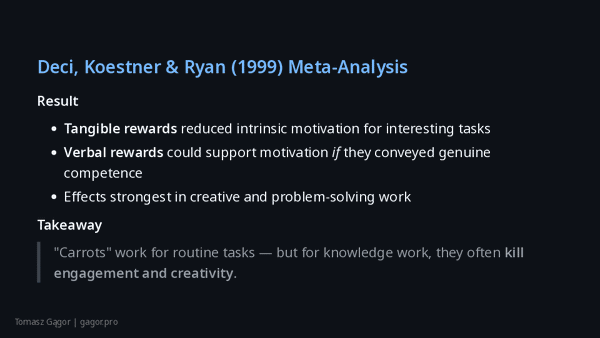I’m a Team Leader for few years already and as part of my duties I take a part in few smaller interest groups. For one of them, I’ve been preparing a presentation or rather a workshop, about “Motivation”.
I wanted it to be a thought-provoking, workshop-style presentation where the title itself (“Why You should not motivate people”) challenges assumptions, and the session helps team leaders reflect on how they may (unintentionally) undermine intrinsic motivation. Idea behind this topic arrived after reading the “Drive” book by Daniel H. Pink .
Writing this post was for me a preparation process, so I could refresh the key points and enhance with examples closer to my role.
Workshop Plan
Duration: ~60–90 minutes.
Depends on the engagement, can scale shorter if needed. Just keep an eye on the clock and skip questions.
Audience: Team leaders, technical managers, IT focused.
Tone: conversational, reflective, not preachy.
Outcome: Leaders leave with self-awareness and 1-2 practical commitments.
1. Opening & Provocation (5–10 min)
- Slide/Title: “Why You Should Not Motivate People?”
- Pause, let people react.
- Ask:
- “What comes to your mind when you read this title?”
- “What do you usually do when you feel your team lacks motivation?”
Your prep/explanation:
People expect leaders to “motivate.” The problem: most think of motivation as adding something (bonuses, speeches, pressure). Pink’s core message: people already have intrinsic motivation - we mostly need to stop blocking it.
2. Traditional View of Motivation (10 min)
- Explain extrinsic motivation: “carrots and sticks” → rewards, bonuses, punishment, micromanagement.
- Share quick example: “If-then” rewards work for simple, mechanical tasks but backfire for complex, creative, problem-solving work (which is what we mostly do in tech).
- Use a quick poll or raise of hands:
- “Who here has offered a small incentive (bonus, position, gifts, other) to boost performance?”
- “Did it create lasting motivation?”
Prep/explanation:
Pink refers to “Motivation 1.0” as the basic instincts: fear, hunger, sex drive - those drive all the animals, including humans. As human beings we had to challenge them to build society. This where “Maslow’s hierarchy of needs”1 might ring a bell.

Although, as many later scientific researches proves - order is not necessarily like that, and many people’s behaviors just don’t fit to this schema.
According to Drive, external motivators narrow focus, reduce creativity, and can kill intrinsic drive.
3. What Science Shows (10–15 min)
- Slide/visual: Self-Determination Theory → Autonomy, Mastery, Purpose.
- Explain Pink’s three pillars:
- Autonomy – the urge to direct our own lives.
- Mastery – the desire to get better at something that matters.
- Purpose – the yearning to be part of something bigger.
Interactive moment:
- Ask:
- “Think about a time you felt deeply motivated at work. Was it because of a bonus? Or because you had space, challenge, and meaning?”
- Let 2–3 participants share stories.
Your prep/explanation:
Research by Edward Deci and Richard Ryan (founders of Self-Determination Theory) shows that when people experience autonomy, mastery, and purpose, they perform better, are more creative, and have higher well-being.
- Deci’s Soma Puzzle Experiment (1971)2: When participants were paid to solve puzzles, their interest dropped once the payments stopped-showing that external rewards can undermine intrinsic motivation.
- Lepper, Greene & Nisbett (1973)3: Children who were rewarded for drawing spent less time drawing later, compared to those who drew for fun.
- Meta-analyses4: Deci, Koestner & Ryan (1999) reviewed 128 studies and found that tangible rewards tend to decrease intrinsic motivation for interesting tasks.
These findings are the scientific backbone for Pink’s argument: leaders should focus on creating environments that support autonomy, mastery, and purpose, rather than relying on external motivators.
4. Turning the Lens on Leaders (20–25 min)
Now guide reflection with open questions. You can split participants into small groups or just do it as an open discussion.
For Autonomy
- “How much decision-making power do I give my team?”
- “Do I trust them enough to choose how to reach outcomes, or do I dictate the steps?”
- “Do I measure success by presence/obedience, or by results and ownership?”
For Mastery
- “Do I create space for people to learn and grow, even if it slows delivery?”
- “Do I encourage experimentation, or do I punish mistakes?”
For Purpose
- “Do my team members know why their work matters to the company and to customers?”
- “When I share goals, do I frame them as numbers to hit, or impact to make?”
Your prep/explanation:
These are not rhetorical. Let people pause, reflect, maybe make notes. The goal is for them to feel a little uncomfortable in recognizing gaps.
5. Practical Shifts Leaders Can Make (15–20 min)
Offer concrete strategies:
For Autonomy:
- Let teams decide how to implement, not just what to deliver.
- Allow flexible work styles where possible.
For Mastery:
- Encourage learning time, pair programming, innovation days.
- Celebrate progress, not just finished products.
For Purpose:
- Share customer stories.
- Connect tasks to mission, not just metrics.
Exercise idea:
- “Pick one pillar (autonomy, mastery, purpose). What’s one small change you could make next week in your team to strengthen it?”
- Have participants share in pairs or groups.
6. Additional materials
I want to provide something, that everyone could try to use alone. I tried to present some flowcharts and decision trees that might help you, to address topic of motivation much easier.
Recognizing motivation patterns
Before trying to “motivate” someone, first recognize what type of motivation is currently at play. Each pattern calls for a different leadership reaction - and not all are about adding energy, sometimes it’s about removing friction.
flowchart LR
A["Observe team member's behavior"] --> B{"What kind of motivation do you see?"}
B --> C[Intrinsic Motivation]
B --> D[Extrinsic Motivation]
B --> E[Apathy / Disengagement]
B --> F[Stress-Driven Motivation]
C --> C1["Driven by curiosity or challenge"]
C --> C2["Enjoys autonomy and mastery"]
C --> C3["Feels connected to purpose"]
C --> C4["✅ Leader action: Support autonomy, remove blockers, offer learning opportunities"]
D --> D1["Motivated by rewards, recognition, or fear of loss"]
D --> D2["Focuses on external validation"]
D --> D3["⚠️ Leader action: Reconnect to purpose, shift focus from reward to meaning"]
E --> E1["Low interest or energy"]
E --> E2["‘Just doing the job’ attitude"]
E --> E3["🚑 Leader action: Re-engage through ownership, connect work to personal impact"]
F --> F1["Motivated mainly by fear or pressure"]
F --> F2["Delivers short-term results, risks burnout"]
F --> F3["💬 Leader action: Reduce pressure, build psychological safety and trust"]
Identify task type & response strategy
This helps to decide if we should use incentives, autonomy, or structure depending on the task’s nature.
Different kinds of work need different motivational strategies. For routine or operational work, structure and even small incentives can help. But for creative or problem-solving tasks - like most software work - autonomy and meaning drive performance more effectively.
flowchart TD
A["Task identified"] --> B{"Type of work?"}
B -->|Routine / Repetitive| C["Clearly defined steps & outcome"]
B -->|Creative / Problem-Solving| D["Unclear path, requires insight"]
C --> E["Focus on consistency & quality"]
C --> F["OK to use clear metrics or small rewards"]
D --> G["Focus on autonomy & exploration"]
D --> H["Avoid controlling rewards"]
E --> I["Support mastery via feedback loops"]
G --> J["Provide purpose & trust"]
Risks of defining the wrong goals
A clear, cautionary slide that ties everything back to leadership mistakes that kill motivation.
Misaligned metrics Rewarding the number of commits instead of value delivered drives wrong behavior.
Output over Outcome People optimize for what’s measured - not necessarily what matters.
Short-term focus Bonuses or targets can create tunnel vision and reduce learning or collaboration.
Crowding out intrinsic motivation Overemphasis on KPIs or rewards signals: “We don’t trust your internal drive”.
Culture impact When goals reward competition, not collaboration - trust and creativity drop.
As a leaders, we have to define goals that connect to purpose, support autonomy, and nurture mastery, rather than simply counting outputs.
7. Closing & Reflection (5–10 min)
Return to the title: “Why You Should NOT Motivate People?”
Wrap-up line:
“Our role is not to motivate - it’s to create the conditions where motivation can thrive. People don’t need us to light a fire under them. They need us to stop pouring water on the fire they already have.”
Final question:
- “What will you stop doing that kills motivation?”
- “What will you start doing to let intrinsic motivation breathe?”
My slide decks
And PDF version here .

